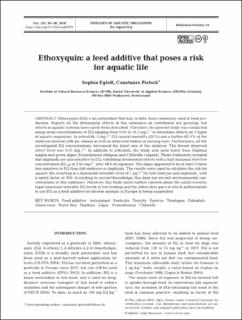Please use this identifier to cite or link to this item:
https://doi.org/10.21256/zhaw-3408| Publication type: | Article in scientific journal |
| Type of review: | Peer review (publication) |
| Title: | Ethoxyquin : a feed additive that poses a risk for aquatic life |
| Authors: | Egloff, Sophia Pietsch-Schmied, Constanze |
| DOI: | 10.21256/zhaw-3408 10.3354/dao03279 |
| Published in: | Diseases of Aquatic Organisms |
| Volume(Issue): | 131 |
| Issue: | 1 |
| Page(s): | 39 |
| Pages to: | 48 |
| Issue Date: | 2018 |
| Publisher / Ed. Institution: | Inter-Research |
| ISSN: | 0177-5103 1616-1580 |
| Language: | English |
| Subjects: | Algae; Antioxidant; Chlorella; Danio rerio; Daphnia; Embryo; Feed additive; Pesticide; Scenedesmus; Teratogen; Toxicity; Water flea; Zebrafish |
| Subject (DDC): | 577: Ecology |
| Abstract: | Ethoxyquin (EQ) is an antioxidant that has, to date, been commonly used in feed production. Reports on the detrimental effects of this substance on vertebrates are growing, but effects in aquatic systems have rarely been described. Therefore, the present study was conducted using serial concentrations of EQ ranging from 0.03 to 16.5 mg l-1 to determine effects on 3 types of aquatic organisms. In zebrafish, 5 mg l-1 EQ caused mortality (25%) and a further 62.5% of the embryos showed yolk sac edema as well as deformed bodies or missing eyes. Furthermore, all the investigated EQ concentrations decreased the heart rate of the embryos. The lowest observed effect level was 0.31 mg l-1. In addition to zebrafish, the study also used water fleas Daphnia magna and green algae (Scenedesmus obliquus and Chlorella vulgaris). These treatments revealed that daphnids are also sensitive to EQ, exhibiting detrimental effects with a half-maximal effective concentration (EC50) of 2.65 mg l-1 after 48 h of exposure. The algae appeared to be at least 2 times less sensitive to EQ than fish embryos or daphnids. The results were used to calculate the risk for aquatic life resulting in a maximum tolerable level of 1 µg l-1 for fish embryos and daphnids, with a safety factor of 300. According to current knowledge, this does not exceed environmental concentrations of this substance. However, this study raises further concern about the (until recently) legal maximum tolerable EQ levels in fish feeding and the rather slow pace at which authorization to use EQ as a feed additive for diverse animals in Europe is being suspended. |
| URI: | https://digitalcollection.zhaw.ch/handle/11475/14502 |
| Fulltext version: | Published version |
| License (according to publishing contract): | CC BY 4.0: Attribution 4.0 International |
| Departement: | Life Sciences and Facility Management |
| Organisational Unit: | Institute of Natural Resource Sciences (IUNR) |
| Appears in collections: | Publikationen Life Sciences und Facility Management |
Files in This Item:
| File | Description | Size | Format | |
|---|---|---|---|---|
| Ethoxyquin a feed additive that poses a risk for aquatic life.pdf | 518.28 kB | Adobe PDF |  View/Open |
Show full item record
Egloff, S., & Pietsch-Schmied, C. (2018). Ethoxyquin : a feed additive that poses a risk for aquatic life. Diseases of Aquatic Organisms, 131(1), 39–48. https://doi.org/10.21256/zhaw-3408
Egloff, S. and Pietsch-Schmied, C. (2018) ‘Ethoxyquin : a feed additive that poses a risk for aquatic life’, Diseases of Aquatic Organisms, 131(1), pp. 39–48. Available at: https://doi.org/10.21256/zhaw-3408.
S. Egloff and C. Pietsch-Schmied, “Ethoxyquin : a feed additive that poses a risk for aquatic life,” Diseases of Aquatic Organisms, vol. 131, no. 1, pp. 39–48, 2018, doi: 10.21256/zhaw-3408.
EGLOFF, Sophia und Constanze PIETSCH-SCHMIED, 2018. Ethoxyquin : a feed additive that poses a risk for aquatic life. Diseases of Aquatic Organisms. 2018. Bd. 131, Nr. 1, S. 39–48. DOI 10.21256/zhaw-3408
Egloff, Sophia, and Constanze Pietsch-Schmied. 2018. “Ethoxyquin : A Feed Additive That Poses a Risk for Aquatic Life.” Diseases of Aquatic Organisms 131 (1): 39–48. https://doi.org/10.21256/zhaw-3408.
Egloff, Sophia, and Constanze Pietsch-Schmied. “Ethoxyquin : A Feed Additive That Poses a Risk for Aquatic Life.” Diseases of Aquatic Organisms, vol. 131, no. 1, 2018, pp. 39–48, https://doi.org/10.21256/zhaw-3408.
Items in DSpace are protected by copyright, with all rights reserved, unless otherwise indicated.